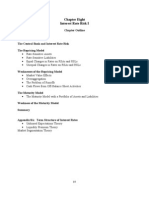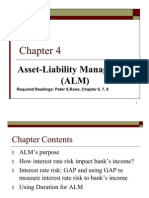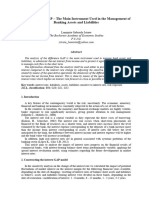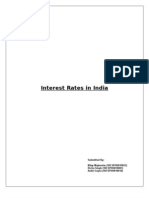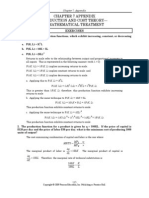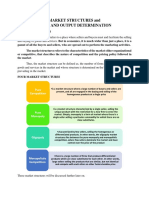Chap 008
Chap 008
Uploaded by
Haris JavedCopyright:
Available Formats
Chap 008
Chap 008
Uploaded by
Haris JavedOriginal Description:
Copyright
Available Formats
Share this document
Did you find this document useful?
Is this content inappropriate?
Copyright:
Available Formats
Chap 008
Chap 008
Uploaded by
Haris JavedCopyright:
Available Formats
Chapter 08 - Interest Rate Risk I
Chapter Eight Interest Rate Risk I
Solutions for End-of-Chapter Questions and Problems. Problems through #20 refer to the re-pricing model. 1. How do monetary policy actions made by the Federal Reserve impact interest rates?
Through its daily open market operations, such as buying and selling Treasury bonds and Treasury bills, the Fed seeks to influence the money supply, inflation, and the level of interest rates. When the Fed finds it necessary to slow down the economy, it tightens monetary policy by raising interest rates. The normal result is a decrease in business and household spending (especially that financed by credit or borrowing). Conversely, if business and household spending decline to the extent that the Fed finds it necessary to stimulate the economy it allows interest rates to fall (an expansionary monetary policy). The drop in rates promotes borrowing and spending. 3. What is the repricing gap? In using this model to evaluate interest rate risk, what is meant by rate sensitivity? On what financial performance variable does the repricing model focus? Explain.
The repricing gap is a measure of the difference between the dollar value of assets that will reprice and the dollar value of liabilities that will reprice within a specific time period, where repricing can be the result of a roll over of an asset or liability (e.g., a loan is paid off at or prior to maturity and the funds are used to issue a new loan at current market rates) or because the asset or liability is a variable rate instrument (e.g., a variable rate mortgage whose interest rate is reset every quarter based on movements in a prime rate). Rate sensitivity represents the time interval where repricing can occur. The model focuses on the potential changes in the net interest income variable. In effect, if interest rates change, interest income and interest expense will change as the various assets and liabilities are repriced, that is, receive new interest rates. 5. What is the CGAP effect? According to the CGAP effect, what is the relation between changes in interest rates and changes in net interest income when CGAP is positive? When CGAP is negative?
The CGAP effect describes the relations between changes in interest rates and changes in net interest income. According to the CGAP effect, when CGAP is positive the change in NII is positively related to the change in interest rates. Thus, an FI would want its CGAP to be positive when interest rates are expected to rise. According to the CGAP effect, when CGAP is negative the change in NII is negatively related to the change in interest rates. Thus, an FI would want its CGAP to be negative when interest rates are expected to fall. 6. Which of the following is an appropriate change to make on a banks balance sheet when GAP is negative, spread is expected to remain unchanged and interest rates are expected to rise?
8-1
Chapter 08 - Interest Rate Risk I
According to the CGAP effect, when CGAP is positive the change in NII is positively related to the change in interest rates. Thus, an FI would want its CGAP to be positive when interest rates are expected to rise. a. replace fixed rate loans with rate sensitive loans
Yes. This change will increase RSAs, which will increase GAP. b. replace marketable securities with fixed rate loans
No. This change will decrease RSAs, which will decrease GAP. c. replace fixed rate CDs with rate sensitive CDs
No. This change will increase RSLs, which will decrease GAP. d. replace equity with demand deposits
No. This change will have no impact on either RSAs or RSLs. So, no impact on GAP either. e. replace vault cash with marketable securities
Yes. This change will increase RSAs, which will increase GAP. 7. If a bank manager was quite certain that interest rates were going to rise within the next six months, how should the bank manager adjust the banks six-month repricing gap to take advantage of this anticipated rise? What if the manger believed rates would fall in the next six months. When interest rates are expected to rise, a bank should set its repricing gap to a positive position. In this case, as rates rise, interest income will rise by more than interest expense. The result is an increase in net interest income. When interest rates are expected to fall, a bank should set its repricing gap to a negative position. In this case, as rates fall, interest income will fall by less than interest expense. The result is an increase in net interest income. 8. Consider the following possible balance sheet positions for a financial institution: Rate-sensitive assets = $200 million. Rate-sensitive liabilities = $100 million Rate-sensitive assets = $100 million. Rate-sensitive liabilities = $150 million Rate-sensitive assets = $150 million. Rate-sensitive liabilities = $140 million (note that each of the above is an independent case) a. Calculate the repricing gap and the impact on net interest income of a 1 percent increase in interest rates for each position.
8-2
Chapter 08 - Interest Rate Risk I
Rate-sensitive assets = $200 million. Rate-sensitive liabilities = $100 million. Repricing gap = RSA - RSL = $200 - $100 million = +$100 million. NII = ($100 million)(.01) = +$1.0 million, or $1,000,000.
Rate-sensitive assets = $100 million. Rate-sensitive liabilities = $150 million. Repricing gap = RSA - RSL = $100 - $150 million = -$50 million. NII = (-$50 million)(.01) = -$0.5 million, or -$500,000.
Rate-sensitive assets = $150 million. Rate-sensitive liabilities = $140 million.
Repricing gap = RSA - RSL = $150 - $140 million = +$10 million. NII = ($10 million)(.01) = +$0.1 million, or $100,000. b. Calculate the impact on net interest income on each of the above situations assuming a 1 percent decrease in interest rates. NII = ($100 million)(-.01) = -$1.0 million, or -$1,000,000. NII = (-$50 million)(-.01) = +$0.5 million, or $500,000. NII = ($10 million)(-.01) = -$0.1 million, or -$100,000.
c. What conclusion can you draw about the repricing model from these results? The FIs in parts (1) and (3) are exposed to interest rate declines (positive repricing gap), while the FI in part (2) is exposed to interest rate increases. The FI in part (3) has the lowest interest rate risk exposure since the absolute value of the repricing gap is the lowest, while the opposite is true for the FI in part (1). 10. What is the gap ratio? What is the value of this ratio to interest rate risk managers and regulators?
The gap ratio is the ratio of the cumulative gap position to the total assets of the FI. The cumulative gap position is the sum of the individual gaps over several time buckets. The value of this ratio is that it tells the direction of the interest rate exposure and the scale of that exposure relative to the size of the FI. 11. Which of the following assets or liabilities fit the one-year rate or repricing sensitivity test? 3-month U.S. Treasury bills 1-year U.S. Treasury notes 20-year U.S. Treasury bonds 20-year floating-rate corporate bonds with annual repricing 30-year floating-rate mortgages with repricing every two years 30-year floating-rate mortgages with repricing every six months
8-3
Yes Yes No Yes No Yes
Chapter 08 - Interest Rate Risk I
12.
Overnight fed funds 9-month fixed rate CDs 1-year fixed-rate CDs 5-year floating-rate CDs with annual repricing Common stock What is the spread effect?
Yes Yes Yes Yes No
The spread effect is the effect that a change in the spread between rates on RSAs and RSLs has on net interest income as interest rates change. The spread effect is such that, regardless of the direction of the change in interest rates, a positive relation exists between changes in the spread and changes in NII. Whenever the spread increases (decreases), NII increases (decreases).
15.
Use the following information about a hypothetical government security dealer named M.P. Jorgan. Market yields are in parenthesis, and amounts are in millions. Assets Cash 1-month T-bills (7.05%) 3-month T-bills (7.25%) 2-year T-notes (7.50%) 8-year T-notes (8.96%) 5-year munis (floating rate) (8.20% reset every 6 months) Total assets Liabilities and Equity Overnight repos Subordinated debt 7-year fixed rate (8.55%)
$10 75 75 50 100 25 $335
$170 150
Equity Total liabilities & equity
15 $335
a. What is the repricing gap if the planning period is 30 days? 3 months? 2 years? Recall that cash is a non-interest-earning asset. Repricing gap using a 30-day planning period = $75 - $170 = -$95 million.Repricing gap using a 3-month planning period = ($75 + $75) - $170 = -$20 million. Reprising gap using a 2-year planning period = ($75 + $75 + $50 + $25) - $170 = +$55 million. b. What is the impact over the next 30 days on net interest income if interest rates increase 50 basis points? Decrease 75 basis points? If interest rates increase 50 basis points, net interest income will decrease by $475,000. NII = CGAP(R) = -$95m.(.005) = -$0.475m. If interest rates decrease by 75 basis points, net interest income will increase by $712,500. NII = CGAP(R) = -$95m.(-.0075) = $0.7125m. 16. A bank has the following balance sheet: Assets Rate sensitive Avg. Rate 7.75%
8-4
$550,000
Liabilities/Equity Rate sensitive $375,000
Avg. Rate 6.25%
Chapter 08 - Interest Rate Risk I
Fixed rate Nonearning Total
755,000 265,000 $1,570,000
8.75
Fixed rate Nonpaying Total
805,000 390,000 $1,570,000
7.50
Suppose interest rates rise such that the average yield on rate-sensitive assets increases by 45 basis points and the average yield on rate-sensitive liabilities increases by 35 basis points. a. Calculate the banks repricing GAP and gap ratio.
Repricing GAP = $550,000 - $375,000 = $175,000 Gap ratio = $175,000/$1,570,000 = 11.15% b. Assuming the bank does not change the composition of its balance sheet, calculate the resulting change in the banks interest income, interest expense, and net interest income. II = $550,000(.0045) = $2,475 IE = $375,000(.0035) = $1,312.50 NII = $2,475 - $1,312.50 = $1,162.50 c. Explain how the CGAP and spread effects influenced the change in net interest income. The CGAP affect worked to increase net interest income. That is, the CGAP was positive while interest rates increased. Thus, interest income increased by more than interest expense. The result is an increase in NII. The spread effect also worked to increase net interest income. The spread increased by 10 basis points. According to the spread affect, as spread increases, so does net interest income. 20. What are some of the weakness of the repricing model? How have large banks solved the problem of choosing the optimal time period for repricing? What is runoff cash flow, and how does this amount affect the repricing models analysis?
The repricing model has four general weaknesses: (1) (2) It ignores market value effects. It does not take into account the fact that the dollar value of rate-sensitive assets and liabilities within a bucket are not similar. Thus, if assets, on average, are repriced earlier in the bucket than liabilities, and if interest rates fall, FIs are subject to reinvestment risks. It ignores the problem of runoffs. That is, that some assets are prepaid and some liabilities are withdrawn before the maturity date. It ignores income generated from off-balance-sheet activities.
(3)
(4)
8-5
Chapter 08 - Interest Rate Risk I
Large banks are able to reprice securities every day using their own internal models so reinvestment and repricing risks can be estimated for each day of the year. Runoff cash flow reflects the assets that are repaid before maturity and the liabilities that are withdrawn unexpectedly. To the extent that either of these amounts is significantly greater than expected, the estimated interest rate sensitivity of the FI will be in error. Problems 21, 22 & 32 refer to the Maturity Model. 21. What is a maturity gap? How can the maturity model be used to immunize an FIs portfolio? What is the critical requirement that allows maturity matching to have some success in immunizing the balance sheet of an FI?
Maturity gap is the difference between the average maturity of assets and liabilities. If the maturity gap is zero, it is possible to immunize the portfolio so that changes in interest rates will result in equal but offsetting changes in the value of assets and liabilities. Thus, if interest rates increase (decrease), the fall (rise) in the value of the assets will be offset by an identical fall (rise) in the value of the liabilities. The critical assumption is that the timing of the cash flows on the assets and liabilities must be the same. 22. Nearby Bank has the following balance sheet (in millions): Assets Cash 5-year Treasury notes 30-year mortgages Total assets Liabilities and Equity Demand deposits 1-year certificates of deposit Equity Total liabilities and equity
$60 60 200 $320
$140 160 20 $320
What is the maturity gap for Nearby Bank? Is Nearby Bank more exposed to an increase or decrease in interest rates? Explain why? MA = [0*60 + 5*60 + 30*200]/320 = 19.6875 years, and ML = [0*140 + 1*160]/300 = 0.5333. Therefore, the maturity gap = MGAP = 19.6875 0.5333 = 19.1542 years. Nearby Bank is exposed to an increase in interest rates. If rates rise, the value of assets will decrease much more than the value of liabilities. 32. What are the weaknesses of the maturity model?
First, the maturity model does not consider the degree of leverage on the balance sheet. For example, if assets are not financed entirely with deposits, a change in interest rates may cause the assets to change in value by a different amount than the liabilities. Second, the maturity model does not take into account the timing of the cash flows of either the assets or the liabilities, and thus reinvestment and/or refinancing risk may become important factors in profitability and valuation as interest rates change.
8-6
You might also like
- Baby Bunting Group - SolutionDocument3 pagesBaby Bunting Group - SolutionDavid RiveraNo ratings yet
- Solutions For End-of-Chapter Questions and Problems: Chapter EightDocument25 pagesSolutions For End-of-Chapter Questions and Problems: Chapter EightSam MNo ratings yet
- Chapter 008 SolutionsDocument6 pagesChapter 008 SolutionsAnton VelkovNo ratings yet
- Gap Analysis For Mib VvvimpDocument208 pagesGap Analysis For Mib Vvvimprohith_yamsaniNo ratings yet
- Financial Risk Management: A Simple IntroductionFrom EverandFinancial Risk Management: A Simple IntroductionRating: 4.5 out of 5 stars4.5/5 (7)
- Sa 110Document2 pagesSa 110coolmanzNo ratings yet
- SolutionDocument4 pagesSolutionAtif KhanNo ratings yet
- Chapter 8 SolutionDocument8 pagesChapter 8 SolutiontalktosarminNo ratings yet
- EOC08 EdittedDocument12 pagesEOC08 EdittedFilip velico100% (1)
- SC Eoc08Document25 pagesSC Eoc08vanessagreco17No ratings yet
- EOC08 UpdatedDocument25 pagesEOC08 Updatedtaha elbakkushNo ratings yet
- Chapter 008Document25 pagesChapter 008Muhammad Bilal TariqNo ratings yet
- Chapter Eight Interest Rate Risk I: Chapter Outline The Level and Movement of Interest Rates The Repricing ModelDocument27 pagesChapter Eight Interest Rate Risk I: Chapter Outline The Level and Movement of Interest Rates The Repricing ModelMuhammad Uzair ShahNo ratings yet
- Questions, Anwers Chapter 22Document3 pagesQuestions, Anwers Chapter 22basit111No ratings yet
- Chapter Seven Risks of Financial IntermediationDocument15 pagesChapter Seven Risks of Financial IntermediationOsan JewelNo ratings yet
- Financial Institutions Management - Solutions - Chap008Document19 pagesFinancial Institutions Management - Solutions - Chap008duncan01234No ratings yet
- Financial Institutions Management - Chapter 5 Solutions PDFDocument6 pagesFinancial Institutions Management - Chapter 5 Solutions PDFJarrod RodriguesNo ratings yet
- Lecture 5: Interest Rate Risk (Part I) : DR Lixiong Guo Semester 2, 2015Document31 pagesLecture 5: Interest Rate Risk (Part I) : DR Lixiong Guo Semester 2, 2015studentNo ratings yet
- Chapter 7Document5 pagesChapter 7Trí Bùi HữuNo ratings yet
- 978 3 319 77458 9Document6 pages978 3 319 77458 9Quỳnh Quang NhưNo ratings yet
- Lec 3 IntRiskDocument21 pagesLec 3 IntRiskMd. Asadul IslamNo ratings yet
- BANK3011 Workshop Week 3 SolutionsDocument5 pagesBANK3011 Workshop Week 3 SolutionsZahraaNo ratings yet
- Chap 8 SlidesDocument88 pagesChap 8 SlidesAfnan100% (1)
- Econ1102 Week 8Document46 pagesEcon1102 Week 8AAA820100% (1)
- CH 8 TabDocument5 pagesCH 8 TabNasser MoslamNo ratings yet
- Asset Liabilities ALMDocument39 pagesAsset Liabilities ALMMoon XinhNo ratings yet
- 55850Document59 pages55850NADEEMAHMAD19903665No ratings yet
- Management of Interest Rate Risk in BanksDocument6 pagesManagement of Interest Rate Risk in BanksPratik NayakNo ratings yet
- Problems To Be Solved in ClassDocument4 pagesProblems To Be Solved in ClassAlp SanNo ratings yet
- Financial Institutin ManagementDocument7 pagesFinancial Institutin ManagementAbu SufianNo ratings yet
- Interest Rate Risk PresentationDocument16 pagesInterest Rate Risk PresentationyolianaaNo ratings yet
- Interest Rate Risk - I A. Saunders - QuestionDocument5 pagesInterest Rate Risk - I A. Saunders - Questions-25-2018621019No ratings yet
- Money and Banking Homework 222222222Document5 pagesMoney and Banking Homework 222222222Sarim ZiaNo ratings yet
- CH 2 NumericalDocument5 pagesCH 2 NumericalJhabindra Pokharel100% (1)
- Ch20 SolutionsDocument19 pagesCh20 SolutionsAlexir Thatayaone NdovieNo ratings yet
- Finance, Banking & Insurance 3.2: Business AdministrationDocument3 pagesFinance, Banking & Insurance 3.2: Business AdministrationSimon KruithofNo ratings yet
- Istrate - Luminita GabrielaDocument5 pagesIstrate - Luminita GabrielaGabriela Luminita IstrateNo ratings yet
- HM ch9 IIDocument3 pagesHM ch9 IIarturoNo ratings yet
- IBA-MBA-Home Assignment-2-SolutionDocument6 pagesIBA-MBA-Home Assignment-2-SolutionIbrahim BadshaNo ratings yet
- 10 MarksqDocument11 pages10 MarksqshivamsyaanNo ratings yet
- Additional QuestionsDocument3 pagesAdditional QuestionsHotel Bảo LongNo ratings yet
- What Is A SwapDocument3 pagesWhat Is A SwapVishnuNo ratings yet
- FI Chapter 3Document12 pagesFI Chapter 3ilifnahomNo ratings yet
- 03 - New Version. Interest Rate and BondDocument89 pages03 - New Version. Interest Rate and BondLee ChiaNo ratings yet
- Abdul Qadir Khan (Fixed Income Assignement No.4)Document8 pagesAbdul Qadir Khan (Fixed Income Assignement No.4)muhammadvaqasNo ratings yet
- CH-004 Investment Appraisal – Further Aspects of Discounted Cash FlowsDocument26 pagesCH-004 Investment Appraisal – Further Aspects of Discounted Cash Flowssabinparajuli64No ratings yet
- Seminar Risk ManagementDocument9 pagesSeminar Risk ManagementDương Nguyễn TùngNo ratings yet
- Session 19 - ALMDocument27 pagesSession 19 - ALMRohit Anil JainNo ratings yet
- FINS3630: UNSW Business SchoolDocument32 pagesFINS3630: UNSW Business SchoolcarolinetsangNo ratings yet
- MID-TERM Examination # 1 (30%) : Interest Paid 6 MillionDocument7 pagesMID-TERM Examination # 1 (30%) : Interest Paid 6 MillionTimbas TNo ratings yet
- Chapter008 SolutionsDocument4 pagesChapter008 SolutionsJimmy JenkinsNo ratings yet
- Why We Need Transparent Pricing in Microfinance November 2008Document62 pagesWhy We Need Transparent Pricing in Microfinance November 2008Vivek ReddyNo ratings yet
- Answers To End of Chapter QuestionsDocument4 pagesAnswers To End of Chapter Questionszordan rizvyNo ratings yet
- BM Asset-Liability ManagementDocument7 pagesBM Asset-Liability ManagementMd. Rakib HasanNo ratings yet
- Banking and Insurance Chapter Seven Solution (4-10)Document5 pagesBanking and Insurance Chapter Seven Solution (4-10)MD. Hasan Al Mamun100% (1)
- Interest Rate RiskDocument58 pagesInterest Rate RiskStevan PknNo ratings yet
- 683sol01 PDFDocument46 pages683sol01 PDFUzma KhanNo ratings yet
- Macro Economics ProjectDocument12 pagesMacro Economics ProjectnilaykmajmudarNo ratings yet
- Financial Modelling of Interest Rate Hedging: Free TutorialDocument2 pagesFinancial Modelling of Interest Rate Hedging: Free Tutorialrksp99999No ratings yet
- DIVIDEND INVESTING: Maximizing Returns while Minimizing Risk through Selective Stock Selection and Diversification (2023 Guide for Beginners)From EverandDIVIDEND INVESTING: Maximizing Returns while Minimizing Risk through Selective Stock Selection and Diversification (2023 Guide for Beginners)No ratings yet
- Monetary Policy and Macroprudential Regulation with Financial FrictionsFrom EverandMonetary Policy and Macroprudential Regulation with Financial FrictionsNo ratings yet
- Economic, Business and Artificial Intelligence Common Knowledge Terms And DefinitionsFrom EverandEconomic, Business and Artificial Intelligence Common Knowledge Terms And DefinitionsNo ratings yet
- Annual Report 2020 PT Berlina TBKDocument348 pagesAnnual Report 2020 PT Berlina TBKBrown kittenNo ratings yet
- Nigerian Crude Oil TradeDocument11 pagesNigerian Crude Oil Tradebiondimi100% (2)
- Luxury Flat ProjectDocument44 pagesLuxury Flat Projectjain2007gauravNo ratings yet
- MIS and Banking IntroductionDocument5 pagesMIS and Banking IntroductionVaibhav GuptaNo ratings yet
- Global Youth Work Key Elements of GlobalisationDocument19 pagesGlobal Youth Work Key Elements of GlobalisationDiana DumitrescuNo ratings yet
- IndnameDocument2,884 pagesIndnameDns MiranNo ratings yet
- Assignment-01: Course Name: Managerial CommunicationDocument6 pagesAssignment-01: Course Name: Managerial CommunicationNaeem AkhtarNo ratings yet
- English 3sci18 1trim3Document2 pagesEnglish 3sci18 1trim3SAFONo ratings yet
- About Warid TelecomDocument6 pagesAbout Warid TelecomIbrahim RafeNo ratings yet
- Oleh: Deni Susanto 212170022 Herlando Bubala 212170020 Matilda Metboki 212170019Document19 pagesOleh: Deni Susanto 212170022 Herlando Bubala 212170020 Matilda Metboki 212170019TiLda MetbokiNo ratings yet
- Chemical Industry ReportDocument11 pagesChemical Industry ReportPardeep MittalNo ratings yet
- Youth Unemployment As Macroeconomic ProblemDocument2 pagesYouth Unemployment As Macroeconomic ProblemnolawitNo ratings yet
- Curriculum Vitae of Mozammel Hoque: Mailing AddressDocument10 pagesCurriculum Vitae of Mozammel Hoque: Mailing AddressMurad ZamanNo ratings yet
- Item Description RCVD Unit Price Gross Amt Disc % Ta Amount DeptDocument1 pageItem Description RCVD Unit Price Gross Amt Disc % Ta Amount DeptGustu LiranNo ratings yet
- JioMart Invoice 1691566063173Document3 pagesJioMart Invoice 1691566063173Aman MadhukarNo ratings yet
- Chapter 7 Appendix Production and Cost Theory - A Mathematical TreatmentDocument4 pagesChapter 7 Appendix Production and Cost Theory - A Mathematical TreatmentchrsolvegNo ratings yet
- Tax Invoice: Taxes RateDocument1 pageTax Invoice: Taxes RateHence Proved ElectricallyNo ratings yet
- FMCG in AfricaDocument2 pagesFMCG in AfricaAnunobi JaneNo ratings yet
- Prahalad HamelDocument3 pagesPrahalad Hamelprateek007soniNo ratings yet
- Economics - Market Structures (From The Book Understanding Economics)Document9 pagesEconomics - Market Structures (From The Book Understanding Economics)Pauline EllaNo ratings yet
- 4 ElasticityDocument54 pages4 Elasticitysneha.tyagi1003No ratings yet
- Mini Case Chapter 5 The Venezuelan Bolivar Black MarketDocument1 pageMini Case Chapter 5 The Venezuelan Bolivar Black MarketNiyant SapaNo ratings yet
- Diagnostic Test Mathematics I: II. Lingini Ang Hustong Bili Sa KwartaDocument3 pagesDiagnostic Test Mathematics I: II. Lingini Ang Hustong Bili Sa KwartaAlexis RamirezNo ratings yet
- PDF MRO AdvertDocument2 pagesPDF MRO AdvertJohnny WakelNo ratings yet
- Industry AnalysisDocument3 pagesIndustry AnalysisHaasnat CheemaNo ratings yet
- Ownership Co-Ownership (2009)Document3 pagesOwnership Co-Ownership (2009)MeAnn TumbagaNo ratings yet
- Analisis Ekualisasi SPT Masa PPN Dengan SPT PPH Badan Terhadap Kewajiban Perpajakan Pt. Adiyana Teknik MandiriDocument6 pagesAnalisis Ekualisasi SPT Masa PPN Dengan SPT PPH Badan Terhadap Kewajiban Perpajakan Pt. Adiyana Teknik MandiriFernando SaputraNo ratings yet
- c2243 - d2890 The New Palgrave Dictionary of Economics 2018Document648 pagesc2243 - d2890 The New Palgrave Dictionary of Economics 2018Johnny Castillo SerapionNo ratings yet















